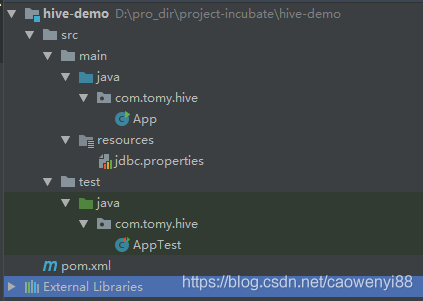这篇文章给大家分享的是有关java maven项目怎么读取配置文件信息的内容。小编觉得挺实用的,因此分享给大家做个参考,一起跟随小编过来看看吧。
目录结构

App.java
package com.tomy.hive;
import java.io.*;
import java.util.Properties;
/**
* Hello world!
*
*/
public class App {
private static String JDBC_URL;
private static String JDBC_DRIVER;
/**
* 读取配置文件
* @return
*/
public static void readConfigFile(String cfgFile) {
try {
InputStream in = App.class.getClassLoader().getResource(cfgFile).openStream();
Properties prop = new Properties();
prop.load(in);
JDBC_URL = prop.getProperty("jdbc.url");
JDBC_DRIVER = prop.getProperty("jdbc.driver");
} catch (IOException e) {
e.printStackTrace();
}
}
public static void main(String[] args) {
readConfigFile("resources/jdbc.properties");
System.out.println(JDBC_URL);
System.out.println(JDBC_DRIVER);
}
}jdbc.properties
jdbc.url=jdbc:mysql://10.6.52.35:3306/test?characterEncoding=utf-8&serverTimezone=UTC&useSSL=false
jdbc.driver=com.mysql.jdbc.Driver<?xml version="1.0" encoding="UTF-8"?>
<project xmlns="http://maven.apache.org/POM/4.0.0" xmlns:xsi="http://www.w3.org/2001/XMLSchema-instance"
xsi:schemaLocation="http://maven.apache.org/POM/4.0.0 http://maven.apache.org/xsd/maven-4.0.0.xsd">
<modelVersion>4.0.0</modelVersion>
<groupId>com.tomy.hive</groupId>
<artifactId>hive-demo</artifactId>
<version>1.0-SNAPSHOT</version>
<name>hive-demo</name>
<!-- FIXME change it to the project's website -->
<url>http://www.example.com</url>
<properties>
<project.build.sourceEncoding>UTF-8</project.build.sourceEncoding>
<maven.compiler.source>1.8</maven.compiler.source>
<maven.compiler.target>1.8</maven.compiler.target>
</properties>
<dependencies>
<dependency>
<groupId>junit</groupId>
<artifactId>junit</artifactId>
<version>4.11</version>
<scope>test</scope>
</dependency>
</dependencies>
<build>
<pluginManagement><!-- lock down plugins versions to avoid using Maven defaults (may be moved to parent pom) -->
<plugins>
<plugin>
<groupId>org.apache.maven.plugins</groupId>
<artifactId>maven-surefire-plugin</artifactId>
<configuration>
<skip>true</skip>
</configuration>
</plugin>
<plugin>
<groupId>org.apache.maven.plugins</groupId>
<artifactId>maven-jar-plugin</artifactId>
<version>3.0.2</version>
<configuration>
<archive>
<manifest>
<addClasspath>true</addClasspath>
<mainClass>com.tomy.hive.App</mainClass>
</manifest>
</archive>
</configuration>
</plugin>
<plugin>
<artifactId>maven-resources-plugin</artifactId>
<executions>
<execution>
<id>copy-resources</id>
<phase>validate</phase>
<goals>
<goal>copy-resources</goal>
</goals>
<configuration>
<outputDirectory>${project.build.directory}/conf</outputDirectory>
<resources>
<resource>
<directory>src/main/resources</directory>
</resource>
</resources>
</configuration>
</execution>
</executions>
</plugin>
</plugins>
</pluginManagement>
<resources>
<resource>
<filtering>true</filtering>
<directory>src/main/resources</directory>
<includes>
<include>**/**.properties</include>
</includes>
<targetPath>/resources</targetPath>
</resource>
</resources>
</build>
</project>

我们maven项目结构如下:

使用相对路径来读取resources目录下的资源文件
InputStream in = new InputStream(new File(“src/main/resources/car.txt”));这样在本地运行的时候,是能正常读取到的,不会报错,但是如果打成jar包,运行的时候就会报路径错误。
从jar包的结构可以看到,resources目录的资源文件位置变了,在项目的最外层了,所以导致相对路径也发生了变化。

这个时候,我们可以通过getClassLoader()方法来获取正确的配置文件路径。
(this也可以换成类的名称)
InputStream in = this.class.getClassLoader().getResourceAsStream(path);这样,在本地运行或者jar包运行都能正常读取到配置文件了。
感谢各位的阅读!关于“java maven项目怎么读取配置文件信息”这篇文章就分享到这里了,希望以上内容可以对大家有一定的帮助,让大家可以学到更多知识,如果觉得文章不错,可以把它分享出去让更多的人看到吧!
亿速云「云服务器」,即开即用、新一代英特尔至强铂金CPU、三副本存储NVMe SSD云盘,价格低至29元/月。点击查看>>
免责声明:本站发布的内容(图片、视频和文字)以原创、转载和分享为主,文章观点不代表本网站立场,如果涉及侵权请联系站长邮箱:is@yisu.com进行举报,并提供相关证据,一经查实,将立刻删除涉嫌侵权内容。